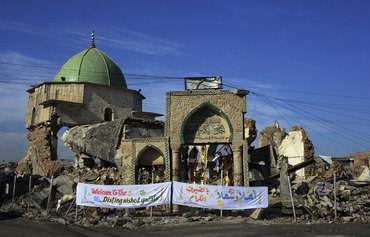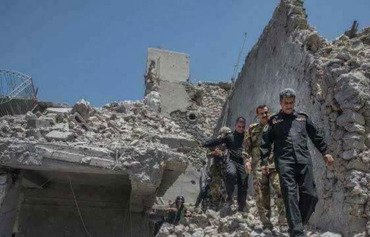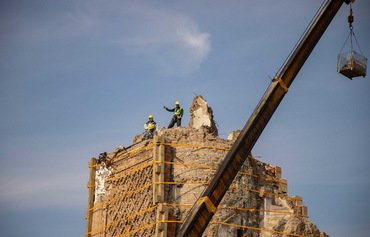MOSUL -- An Iraqi museum is using computer technology and virtual reality (VR) headsets to turn back time and enable visitors to explore the country's heritage sites destroyed by insurgents or damaged during battles with terrorists.
Elements of the "Islamic State of Syria and Iraq" (ISIS) captured a third of Iraq in a lightning offensive in 2014, seizing the northern city of Mosul as their stronghold, and vandalising or destroying a large number of cultural sites across the country.
Significant reconstruction activity is under way in the Ninawa provincial capital of Mosul, transforming the city's appearance five years after it was left in ruins by ISIS.
Iraqi Prime Minister Mustafa Kadhemi launched the highly anticipated reconstruction project of Mosul airport on August 10. The airport will be rebuilt and improved to prepare for international flights as well.
Virtual Mosul
Using thousands of photographs, a group of local engineers have given new virtual life to five historic sites in Mosul and the broader Ninawa province. A mosque and its leaning minaret are among these sites.
"It takes you to another world," said Mahiya Youssef after exploring the 3D images of damaged buildings with VR goggles at the Mosul Heritage House museum.
"I really wish it was the real Mosul, not just a virtual version," added Youssef, 50, who works in a food factory in the city. "The return to reality is painful."
The ISIS group's then-chief, Abu Bakr al-Baghdadi, made his only confirmed public appearance at Mosul's Al-Nuri mosque, where he declared the establishment of a "caliphate".
Mosul's Old City was reduced to rubble during the battle to liberate the city from ISIS. Its mosque and the adjacent leaning minaret, nicknamed Al-Hadba or the "hunchback", were destroyed in the battle.
Iraqi authorities have accused ISIS of planting explosives at the site before withdrawing from it. Only the minaret's base survived the explosions.
VR technology, including at a UNESCO-backed exhibit in the United States, has been used before to recreate the heritage destroyed by ISIS.
But this museum brings sites back to life for residents of Mosul.
"Many children have never seen the Al-Nuri mosque and its Al-Hadba minaret," said 29-year-old Ayoub Younes, founder of the VR museum.
"We try, through [VR], to let the person experience visiting those sites and retrieve those memories."
The private museum with a marble facade, sitting along the Tigris river, opened in mid-June and saw more than 4,000 visitors in the first month, Younes said.
Other sites on the virtual visit are the historic Al-Tahera church, tucked among the once meandering alleyways of the Old City, and the Hatra archaeological site, more than 2,000 years old, in the desert south of Mosul.
Insurgents took guns and pickaxes to the once extensive remains of the ancient city, releasing video footage in 2015 of the destruction.
'Saving Mosul's memory'
On his computer screen, Abdullah Bashir showed a 3D replica of the mosque housing the Nabi Yunus shrine -- revered by both Muslims and Christians as the tomb of Prophet Jonah -- which the extremists blew up in 2014.
"We used personal photos and shots taken by residents" to reconstruct the sites in their former state, he said.
But there were "very few" images before 2014, he said.
Bashir and other specialised engineers have brought the former scenes back to life, in a project he says is "a way of saving the memory of Mosul".
Many of the exhibits are daily-life objects donated by local families, from terracotta amphoras to oil lamps, traditional wall hangings, metal containers and even an old radio.
After his virtual tour, visitor Mohammed Abdullah pushed his wheelchair around the real-life displays in the museum's vaulted rooms.
The contrast between the VR and the reality of Mosul was painful, said Abdullah, 28, a student of telecommunication engineering, agreeing with other visitors.
"Reconstruction is extremely slow, and is not equal to the devastation," said Abdullah.
He called for faster restoration of heritage sites both to attract tourists and to "breathe life" into nearby areas.
"The day will come when we will make this visit in reality," he said. "It will be even better than the virtual one."

![A visitor donning 3D goggles views reconstructed models of ancient artefacts destroyed during the occupation of Mosul by 'Islamic State of Iraq and Syria' (ISIS) group fighters, at the 'QAF Lab' (representing the Arabic letter 'qaf') Virtual Museum in Mosul on August 3. The Mosul museum is using virtual reality to let visitors explore ravaged heritage sites in northern Iraq as they appeared before ISIS unleashed a wave of destruction. [Zaid al-Obeidi/AFP]](/cnmi_di/images/2022/09/06/36979-mosul-600_384.jpg)






